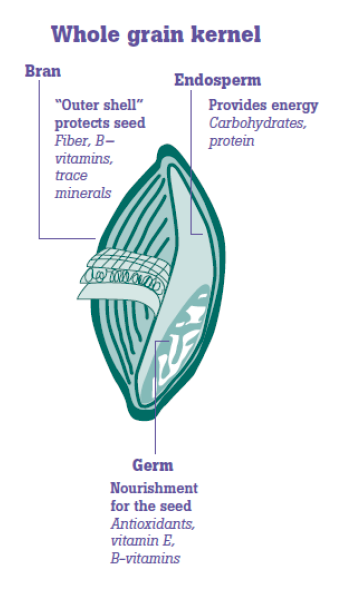Today’s post was written by VT Dietetic students Hannah Winston, Miriam Eackloff, Darian Carter, Kendall Holloway, Ali Moore.
There are two types of grains: whole grains and refined grains. Whole grains contain the entire kernel and refined grains have been milled. Milling is a process that removes the bran and the germ, helping make grains more shelf-stable. But milling also gets rid of many important nutrients, such as dietary fiber, iron, and other vitamins found in the bran and germ. Dietary fiber aids in digestive processes and iron is important for red blood cell production. Because whole grains contain more of these important nutrients, we should aim to make at least half our grains whole grains.
Reading the ingredients is the best way to determine if a food is made with whole grains (see tips 1 and 2 on this fact sheet from MyPlate). Some examples of whole grains include:
- Whole-wheat flour
- Oatmeal
- Bulgur
- Whole cornmeal
- Brown rice
For even more information, including recipes and more examples of whole grains check out this post. Here are some tips from VT Dietetic students that you can use to incorporate more whole grains into your own meals:
“To start eating more whole grains, I put granola in my cereal and yogurt. Granola can have anything from whole grain oats to brown rice to whole grain wheat. It adds an extra crunch, and they come in so many different varieties and flavors that I never get sick of it!” ~ Hannah Winston
“When I go out to eat for a sandwich or sub, I always ask if I can substitute the white bread or roll with a whole grain version. In my opinion, they all taste very similar and the other flavors and ingredients in the sandwiches make it mix very well.” ~ Kendall Holloway
“I have a whole grain at dinner every night. In order to not get tired of the same grains, such as rice or pasta, I started experimenting with new ones. Recently, I made quinoa, and loved it. Another kind I might add to the mix will be barley. I know this helps keep me excited to eat more whole grains.” ~ Darian Carter
“When I make whole grains like bulgur or quinoa, sometimes I make extra and freeze half of it so I know I have a side dish for one of those days I’m short on time.” ~ Ali Moore
“When I make bread, cornbread, or other recipes that call for flour, I like to replace the white flour with whole wheat flour, usually by half. Sometimes in bran muffins and other recipes, I replace one-third or half of the white flour with rolled oats. My friends don’t even notice!” ~ Miriam Eackloff
What are your family’s favorite whole grain foods?

